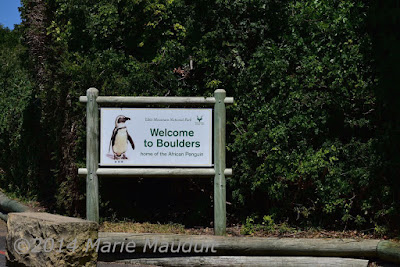There is an easy way to go from Cape Town and from Muizenberg to Simon’s Town. You can get there by train. Using the Southern Rail Line Route, you’ll travel along the coast which is very beautiful. Of course, reading the safety instructions on the train website will probably put a lot of tourists off. Just remember that these instructions apply to any place in South Africa. Be careful and your travel will be very enjoyable.
We chose to go by car since the trains don’t run to Cape Point, the terminus being Simon’s Town. We wanted to drive through Simon’s Town on our way to Boulders Beach and from there, to the Cape of Good Hope.
One or two words about Simon’s Town. As usual, it was named after a former Dutch governor, Simon van der Stel who arrived in the colony in 1679 and decided that False Bay would be a much safer alternative to the Cape Bay during winter. Its Afrikaans name is Simonstadt. For the past two centuries, it has been an important naval base, first for the Royal Navy and then for the South African Navy as early as 1922.
The Victorian buildings in Simon’s Town have been very well preserved, at least along St George’s Street and quite amazing.
There is a “Historical Mile” just like in Muizenberg but we were in a hurry and we were famished. We stopped at the Seaforth Restaurant mainly because it has a very convenient outside deck which overhangs the sea and offers a beautiful view of the False Bay mountains. And… the icing on the cake… there they were, my first penguins... Just don't forget to turn onto "Gay Road".
Facing the restaurant, there is this huge building which is the South African Institute for Maritime Technology. Read institute for defense research “to satisfy South African MoD strategic needs for techno-military support, products and services and to establish applicable technology and systems to further the interest of the SANDF.” A very serious place to work indeed but since you are in South Africa, lunch break turns into beach time which can be a real perk, I think. Quite a few people there do not hesitate to don swimming suits and plunge into the water while others take a walk along the beach. Nice, isn’t it!
I couldn’t wait to get to Boulders Beach which is a very beautiful place. Guess why it is called "Boulders Beach"!
The reason why I couldn't wait... Because this is the place where one couple of African penguins decided to settle down some time in 1983. The area was already highly inhabited by humans but the penguins took up residence there anyway and the colony expanded. Now they are very protected and to watch them you need to follow a wooden walkway. But first you have to pay an entrance fee (60 rands. About 4 dollars or euros).
There are rangers all over the place in order to insure the birds’ security . And the tourists’ safety also, by the way. Penguins are known to nip intruders and they have razor-sharp beaks. And this can be a disagreeable experience, I have been told.
African penguins are an endangered species. There were millions of them when the Dutch settled in the Cape area in 1652, and still millions of them in the 1930s. Less than a century later, there are only about 1.200 mating pairs left. Why? Well, you know, always the same problems more or less. Pollution and oil spills. Dwindling fishing ressources due to climate change and industrial fishing. Nesting in a rather unsafe environment even if they are protected from the tourists, they are not protected from mongoose, genets nor cats and dogs and kelp gulls too, of course.
Those penguins are rather small and far less good-looking than their Antartic counterparts, the Emperor Penguins. Probably because they do not belong to the same species. The Emperor Penguins are Spheniscidae (and are called “Manchots” in French) while the African Penguins are Alcidae. They used to be nicknamed “Jackass” penguins because they are rather noisy and kind of bray, a lot like donkeys even when they are young, believe me.
Of course, they are fun to watch. They waddle along but as soon as they hit the water edge, they turn into sea missiles, sort of. They can swim as fast as 7 kms/hour. They usually go fishing way off from their colony and therefore they are very vulnerable to predators like sharks, Cape fur seals and sometimes killer whales.
In October when we were in Boulders, it was moulting season which is not really the best time to watch them. Someone said that they look sad and depressed… How would you feel if you were to loose your feathers and worse if you were fasting for two months? Because this is what moulting is all about, starvation. Penguins do not swim out to the open sea to feed while they are moulting.
It was hard to leave Boulders which is a magnificent place and the penguins. But remember, we were on our way to a place I had dreamed about for a long, long time… The Cape of Good Hope. And we were running late…
*Good Luck, and Good Night*

















































